Top 20 Link-Based Ranking Factors – Part 2 of 3
Contents
On the previous page, we discussed various ranking factors that are organized around links. We covered the concepts of PageRank, TrustFlow, link rot, exact match anchors, branded anchors and anchor text diversity. We continue this list below, starting with diversity of link source types.
Diversity of Linking Sources
 It should make sense that you do not want 100% of the links to your money site to be from WordPress blogs, or 100% from free blogs, or 100% with quality comment links, or 100% from guest blog posts. The key is to have diverse sources for your links. It is important to remember that as you strive for diversity, do not link with bad link types.
It should make sense that you do not want 100% of the links to your money site to be from WordPress blogs, or 100% from free blogs, or 100% with quality comment links, or 100% from guest blog posts. The key is to have diverse sources for your links. It is important to remember that as you strive for diversity, do not link with bad link types.
A well rounded link portfolio would include the following types of self-generated links: social links (from popular accounts), direct social links and shares/retweets that contain links, web2.0s where the content is unique, WordPress blogs where the content is unique, links from higher quality comments where the comment is unique, guest blog posts where the site is relevant to your niche.
Next, you would strive to get links from leaders in your niche, who have higher quality websites. It pays to do social networking and building relationships with these leaders. One of the more popular link types today is from “expert roundup” types of blog posts, where you feature opinions of many experts, and thereafter they link to the article. The key here is to avoid your links consisting of only this, or only that. Having diverse link sources shows you’re less likely to be building your links yourself.
Diversity of Link Types
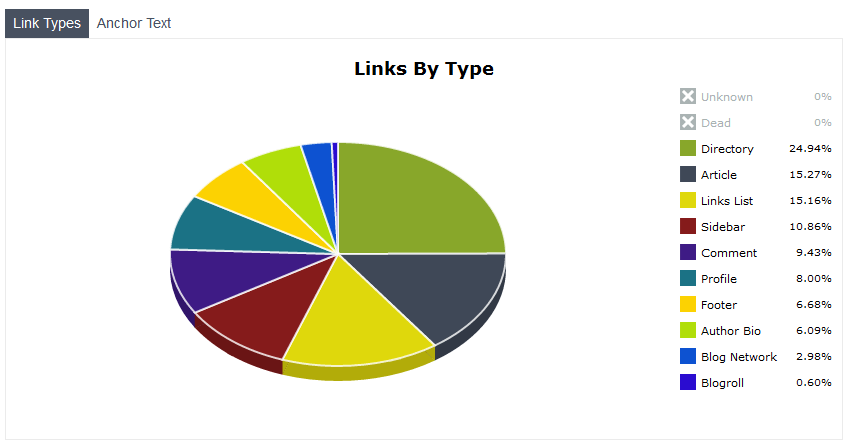 There are different types of links when considering how they’re constructed. Some distinctions would be do-follow vs nofollow, links that have anchor text and links that are only a raw URL, and links that are text anchors vs links that are linked from images. If all of the links to your site were of only one link type, this is an unnatural link portfolio. It looks rather fishy, especially if you have lots of links, and yet not a single nofollow link. Google knows how many links, on average, are nofollow, and if your site’s links are outside of that range, it simply looks odd. Get a variety of link types, including follow, nofollow, keyword anchors, raw url anchors, and image for anchor, to appease Google’s algorithm.
There are different types of links when considering how they’re constructed. Some distinctions would be do-follow vs nofollow, links that have anchor text and links that are only a raw URL, and links that are text anchors vs links that are linked from images. If all of the links to your site were of only one link type, this is an unnatural link portfolio. It looks rather fishy, especially if you have lots of links, and yet not a single nofollow link. Google knows how many links, on average, are nofollow, and if your site’s links are outside of that range, it simply looks odd. Get a variety of link types, including follow, nofollow, keyword anchors, raw url anchors, and image for anchor, to appease Google’s algorithm.
Velocity of Links
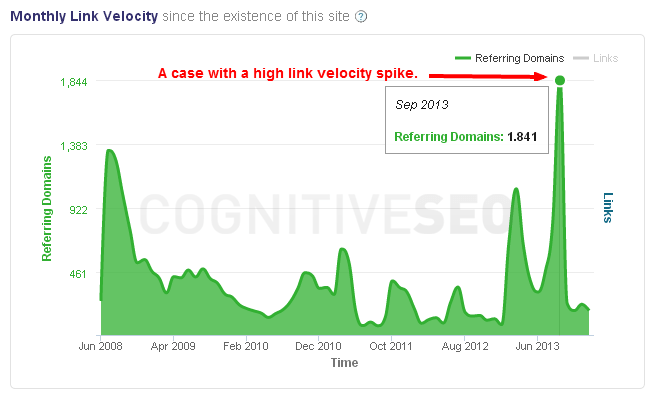 Your website receives links over a certain timespan. The idea is that you will build links naturally, over time. One site may receive a flood of links at once, and then none. Another site receives links spread over time, consistently. While some sites may naturally receive a flood of links (think: something newsworthy just happened causing the link), it is not natural to receive many links, and then none.
Your website receives links over a certain timespan. The idea is that you will build links naturally, over time. One site may receive a flood of links at once, and then none. Another site receives links spread over time, consistently. While some sites may naturally receive a flood of links (think: something newsworthy just happened causing the link), it is not natural to receive many links, and then none.
Receiving no links would imply that your flood of links was a one-time event, and now that it is over you’re no longer relevant. Most likely, it implies you bought a link package, and they delivered them quickly. You want to avoid this “flood of links, and then nothing” signal. It makes sense to build links slowly, over time. This would be more consistent of a constantly relevant website that is just as current today as it was when the links first started.
Keyword Proximity of Links
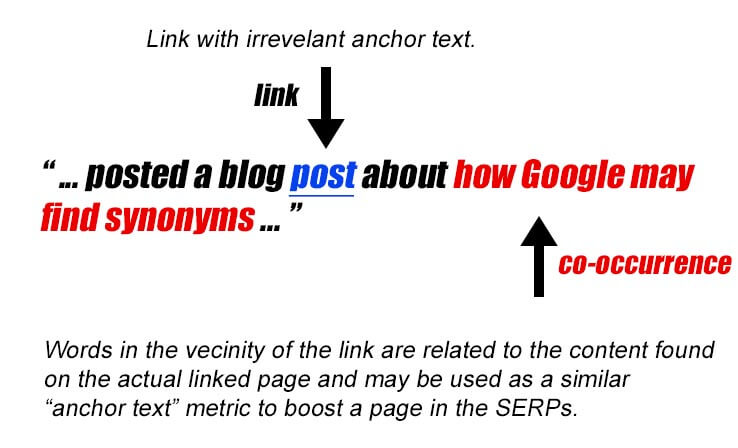 Although I recommend that you do not use exact keywords in links often, I do recommend putting keywords very close to the links you build. Google must determine the context in which your link was created. Make it easy for them, use the keyword you want to rank for in the same sentence from which the link comes. By doing this, it gives Google the clue it needs to turn “click here” into a meaningful link signal. Google doesn’t like to be told how to rank a page (by you putting a keyword in anchor text). Instead, they like to think they figured it out all by themselves (by detecting the keywords that were in proximity to the link).
Although I recommend that you do not use exact keywords in links often, I do recommend putting keywords very close to the links you build. Google must determine the context in which your link was created. Make it easy for them, use the keyword you want to rank for in the same sentence from which the link comes. By doing this, it gives Google the clue it needs to turn “click here” into a meaningful link signal. Google doesn’t like to be told how to rank a page (by you putting a keyword in anchor text). Instead, they like to think they figured it out all by themselves (by detecting the keywords that were in proximity to the link).
Social media often doesn’t use anchor texts. In Twitter, links are shortened. Google is forced to determine the context of the link in order to determine which niche the link is associated with, and determine contextually whether the link is relevant to your site.
Contextual Placement of Links
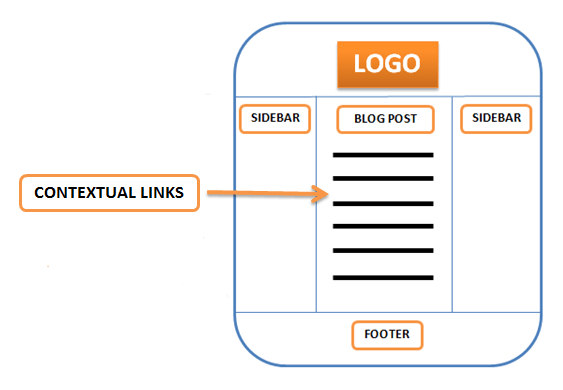 The only links on your site that really matter are the ones that are found in content. If Google finds a link in content, it is far more weighted than if that link were discovered in boilerplate text, such as your navigational menu or footer area. This goes for external links, but it also goes for internal links.
The only links on your site that really matter are the ones that are found in content. If Google finds a link in content, it is far more weighted than if that link were discovered in boilerplate text, such as your navigational menu or footer area. This goes for external links, but it also goes for internal links.
For example, linking to your homepage with desired keywords in content is a very important thing to do. Don’t skip it just because you think that the menu system has a link to the homepage, and that’s enough. Google doesn’t determine relevancy of links found in the menu, sidebar or footer. Only by links found in content, where Google can determine the context of the link, will Google consider the link as conveying excellent rankings.
Relevancy of Links
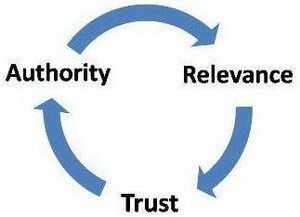 This is a major ranking factor. Having links, in relevant content is the way to build #1 rankings. In practice, you will want to construct content related to your niche, then build links to your site from that content. Linking to your site from non-relevant sources, that represent different niches, is not wise and will typically result in penalties if you do it too much.
This is a major ranking factor. Having links, in relevant content is the way to build #1 rankings. In practice, you will want to construct content related to your niche, then build links to your site from that content. Linking to your site from non-relevant sources, that represent different niches, is not wise and will typically result in penalties if you do it too much.
When you link to content from external sources, you want those sites to be related to your niche. In addition, when you link within your own content, from page to page, you want to keep your links flowing between content that is the most related. One excellent way of doing this is using YARPP (yet another related posts plugin). YARPP uses an algorithm and examines your title, body, and categories to decide which pieces of your content are most related to others. Then, at the bottom, the page links only to the other pages on your site that are most related.
Links From Bad Neighborhoods
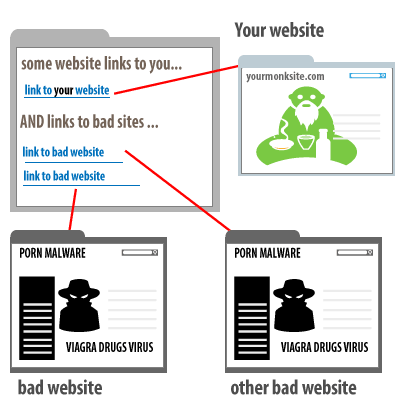 Google often discusses the concept of “bad neighborhoods”. These are things such as link farms. Link exchanges, where you sign up to some script and post reciprocal links, are an example. When Google goes in and raids some poor public blog network, or MyGuestBlog guest blog exchange service, the sites found within those services then become bad neighborhoods. “Porn, gambling and pharm” are examples of seedier content that should not be associated with your unrelated content. It used to be that only linking to bad neighboorhods would get you in trouble. Today, you can get penalties when they link to you. Getting links from them convey penalties. It is advised that you stay away from the lower quality links available from various bad neighborhoods.
Google often discusses the concept of “bad neighborhoods”. These are things such as link farms. Link exchanges, where you sign up to some script and post reciprocal links, are an example. When Google goes in and raids some poor public blog network, or MyGuestBlog guest blog exchange service, the sites found within those services then become bad neighborhoods. “Porn, gambling and pharm” are examples of seedier content that should not be associated with your unrelated content. It used to be that only linking to bad neighboorhods would get you in trouble. Today, you can get penalties when they link to you. Getting links from them convey penalties. It is advised that you stay away from the lower quality links available from various bad neighborhoods.
You’re reading the top 20 ranking factors that are related to links. You just finished reading #13, continue through to #20 in our final article. Up next: the positive ranking signals passed by links that convey author rank.

Comments